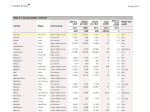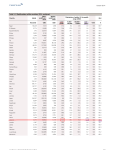Lebanon isn’t a country where population studies are omnipresent. However, given the data that the country has, Credit Suisse, in their yearly report on Global Wealth, has managed to paint a picture on how things in this country actually are.
The report dates back to October 2014, and frankly I am surprised that these numbers did not cause a stir and were not discussed. The report, at 160 pages, can be found here. Perhaps no one noticed the info, so here they are:
At an estimated population of 4.37 million, Lebanon’s wealth is estimated at $91 billion. That actually constitutes 0% of global wealth. How anticlimactic.
When it comes to the Middle East, and despite the reputation we get of being oil-rich, things are similar: Saudi Arabia has an estimated wealth of $653 billion, which ends up as roughly 0.2% of global wealth. Qatar, and all our shoukrans, has $200 billion, which is 0.1% of global wealth. The UAE is at $461 billion, and 0.2%. Meanwhile, Israel has an estimated wealth of $843 billion, translating to 0.3% of global wealth.
All of these numbers look flimsy compared to the United States’ $83708 billion, constituting 31.6% of world wealth.
Keep in mind that – with the exception of Israel and the United States – Credit Suisse considers the data for Lebanon and other Middle Eastern countries to be poor in quality. However, I highly doubt that any estimations are overly erroneous in any way or that the margin of error they are admitting to will change the findings considerably.
But this isn’t the story. We all know the country has money. Recent leaks out of Switzerland placed the country at #11 in total customers at their banks and #12 in total deposits within the few months whose data was actually leaked. We’re 10452 km2. That’s a lot (link).
The story is in how that money is actually divided on the 4.3 million Lebanese living here.
Out of all those $91 billion, 0.3% or approximately 8000 people of the estimated workforce according the study own about half (48% to be exact), which is approximately $44.6 billion. Meanwhile, 99.7% of Lebanese own slightly more than half at $46.4 billion.
To put those numbers in perspective, Credit Suisse employed a criteria called the Gini score. The score, according to Wikipedia, is essentially a “measure of statistical dispersion intended to represent the income distribution of a nation’s residents, and is the most commonly used measure of inequality.”
Lebanon’s Gini score is 85.6. a score of 85.6 places Lebanon 6th worldwide in terms of wealth inequality behind Ukraine, Denmark, Kazakhstan, Seychelles and Russia.
The story doesn’t end here. Even among those 0.3%, there are disparities. That 0.3% basically any Lebanese who has an estimated wealth above $1million. But who actually owns most of the country? The answer is two families: The Hariri and the Miqatis.
According to the Forbes latest list of billionaires, there are 6 Lebanese on the list whose ranking ranges from 530 worldwide to 1478. Two of those 6 are the Miqati brothers. The other 4 are the Hariri brothers, including former PM Saad Hariri. Their cumulative wealth is estimated, according to Forbes, at $12.6 billion. This is 30% of the total wealth owned by those 0.3% of Lebanese – except it’s owned by just 6 men.
This isn’t to say that the Hariris and Miqatis do not deserve their wealth. The Miqatis started and ran a telecom empire. The Hariris started and ran a major contracting company in Saudi Arabia. Good for them.
The problem with these numbers is the other side that they portray. About two thirds of the Lebanese population (64.6%) have an estimated wealth of less than $10,000. Such numbers indicate massive poverty in the country, and yet I was unable to find substantial studies apart from one that was recently done by the UN about Tripoli.
In numbers, (link) the UN found that 57% of Tripoli’s families struggle to reach an acceptable standard of living, while 26% are considered extremely deprived. It wouldn’t be a stretch to assume that things are similar in other regions beyond Beirut.
To the background of this massive poverty is the 0.3% who owns 50% of the country’s wealth, and those 0.3% happen to include most (if not all) of our politicians. Aoun is in it. Geagea is in it. Our MPs and ministers are probably part of those 8000 people too. There are no estimates of the wealths of Lebanese politicians if their last name isn’t Hariri or Miqati, but one assumes they are not middle class folk who are going by paycheck to paycheck.
Of course, it only makes sense that money brings influence, and then influence brings power. A politician’s job in Lebanon isn’t only to legislate but to “provide” for the voters. This is how democracy works here.
The problem with those 0.3% (not all of them obviously) being those running the country is that the country’s policies over the years have not served to close the gap or make those 64.6% with little to no wealth slightly better off. The Gini coefficient clearly shows as much. The country’s policies have not aimed at improving education, providing economic opportunities (for instance, a 1 million m2 zone in Tripoli to bring in international technology has been on hold over sectarian causes for the past 6 years) or making living standards better. Those 0.3% do not get how things are for the 64.6%, the people they’re in contact with once every 4 years for that pre-electoral paycheck. And honestly, there’s no reason for them to get it. And yet our MPs and ministers wanted to increase their salaries?
Meanwhile, the Lebanese population who happens to be of the third that has wealth above $10,000 is pre-occupied with selfies, porn stars, bananas and Kardashian-like reality TV shows because those are what matters.




